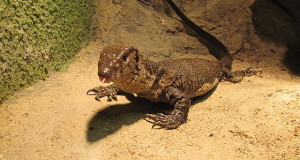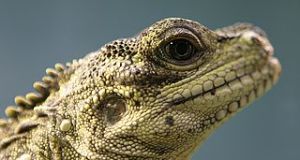Note: Please see The Monitor Lizards (Family Varanidae) – Family Overview and Species Accounts
for information on the natural history of monitor lizards.
Storr’s Pygmy Monitor, Varanus storri
This is the smallest monitor regularly available in the pet trade. Also nearly the tiniest member of the family Varanidae, this species has much to recommend it as a “first monitor”. Reaching just 14 inches in length, Storr’s monitor is one of the only monitors that can be housed within an aquarium-sized (see below) enclosure when adult.
A Popular Pet
Storr’s monitors are immensely popular because they combine all of the typical monitor traits in a small package – indeed, they act exactly like tiny versions of their larger cousins. What they lack in size is more than made up for in attitude, and they are quite bold as captives. In fact, keeping more than one in a cage, even a mated pair, is difficult due to their aggressive natures.
Range
This plucky, brown little lizard hails from northeastern Australia. A subspecies, reddish in color but otherwise similar (V. s. ocreatus) ranges further west. In the eastern part of its range, Storr’s monitor is threatened by the introduced marine toad, which both preys upon and competes with it. Populations have all but disappeared from some areas already.
Housing
Storr’s monitors are quite active and should be housed in a tightly secured aquarium of at least 30 – 55 gallons (“long models are best”). They require a source of UVB light and a basking site that reaches 90 F or so.
Diet
Although they are often fed pink mice and small rodents in captivity, the natural diet of this species consists largely of insects. The bulk of their food in captivity should be roaches, crickets, waxworms, super mealworms, mealworm beetles and wild-caught insects. Canned insects, such as silkworms and grasshoppers, offer an excellent source of dietary variety. Many individuals also accept canned monitor diets.
Breeding
Captive breeding is possible, but pairs must be watched closely for aggression. The 2-5 eggs hatch in 100 days at 82F.
Crocodile Monitor, Varanus salvadorii
Crocodile Monitor
At the other end of the spectrum from Storr’s monitor is southern New Guinea’s massive crocodile monitor – it approaches 9 feet in length (nearly as long as, but much lighter than, the Komodo dragon), and there are unverified reports of much longer individuals. The prehensile tail is twice as long as the snout-vent length. Crocodile monitors are black in color and boldly marked with yellow spots, and sport long claws and a bulbous snout (particularly so in mature males).
Range
Highly arboreal despite their size, crocodile monitors dwell in the canopies of lowland forests in the vicinity of rivers and mangrove swamps. Little is known of their status in the wild, but there is concern given the limited range; the species is listed on CITES Appendix II.
Warning!
In contrast to the other lizards described here, crocodile monitors are suitable only for very advanced hobbyists, or as zoo animals. Those I worked with learned to tolerate my presence, but remained wary and agressive even after many years.
In contrast to the usual structure of monitor teeth, those of the crocodile monitor are serrated and over-lapping – possibly an adaptation to holding onto and carrying large prey high above the forest floor. These animals are formidable predators, and capable of inflicting potentially life-threatening wounds.
Housing
Captive-bred animals are available and adjust moderately well (please see above) if given huge, high-topped enclosures that accommodate their arboreal lifestyles – forcing crocodile monitors to remain on the ground is, in my experience, quite stressful to them.
A cage or room of 10’ x 10’ by 10’ would be required for a single adult. UVB light and a basking spot of 90-95 F are needed. A humid environment is preferred, but they must be able to dry off as well.
Diet
Wild crocodile monitors feed upon cuscus, young tree kangaroos, naked-tailed rats, bandicoots, bats and other mammals, birds and their eggs, frogs, snakes, lizards and carrion. Captives do well on rats, mice, chicks, crayfish, large roaches and hard-boiled eggs.
Image referenced from Wikipedia.
Check back on Friday for more Monitor Species Profiles.
 That Reptile Blog – Reptile, Amphibian and Exotic Pet Care and Information
That Reptile Blog – Reptile, Amphibian and Exotic Pet Care and Information




hey! great review!!! thanks usefull
Hello Alex, Frank Indiviglio here. Thanks so much for taking the time to write in.
I look forward to hearing about your interests, and to any comments or questions you may have.
Good luck and please keep me posted.
Best regards, Frank Indiviglio.
good…usefull
Hello Andrew, Frank Indiviglio here. Thanks for your interest in our blog and for your kind comment.
I look forward to hearing about your interests. Please be in touch with any questions or comments as well.
Enjoy, good luck and please keep me posted.
Best regards, Frank Indiviglio.
Hi Frank,
I have two croc monitor one of m 1,60 long and 4 years old sex unknown, I have seen kind of hemipenis while he was defecating but I read that also the female have a kind of short hemipenis……and a second one 100% male one year old and long m 1,70……..I feed them 2 x week 3 rats 80 grams each……..I d like to know the rigth feeding schedule; at what age they reach sexual maturity and the maximum weigth
Thanks a lot
Hello Alfonso, Frank Indiviglio here.
Nice to hear from you. The female structure you describe seems to be present in all monitor species, and many or all other lizards. It is not usually everted as occurs with the male’s hemipenes, but if this does occur it would be difficult to distinguish it from the male organ, other than by size. You’ll need to watch them closely, because if both are males they may fight.
We know very little about their natural history, including reproduction, growth rates, etc. Captive observations indicate that females have become sexually mature at a size of appx 1.3 meters, males a bit longer, but really no way to tell if this is average. Growth rate depends so much upon diet and temperature; without field research it is difficult to predict.
Food intake is highly dependent on temperature and also activity levels; appearance is your best guide – over-fed monitors exhibit huge stomachs and swell along the sides, and become less active. Protruding hip bones indicate thin animals. Keep in mind that many species will feed even if temperatures are not ideal; learned this the hard way years ago – a group of adult Water Monitors became ill and some perished because temperatures were warm enough for them to feed, but not to digest properly; be sure to provide basking spots of 95 F or more; bulbs must be out of reach of the lizards less they start a fire.
Sorry there is not much specific info available – but this puts you in a good position to add to our knowledge. Please keep detailed notes and write in when you can with your observations.
Good luck and please keep me posted.
Best regards, Frank Indiviglio.
We as are many others at Fern Acres are building our aquaponic farm in the rain forest of the Big Island, Hawaii. Have you further thoughts on constructing termite collecting devices for feeding fish. Termites appear to be an inexhaustable source of fish protein in the rain forest. WSYale@comcast.net
Thanks for your interest in our blog. I agree…I’m always surprised by their abundance in so many habitats I’ve seen; studies have shown that they are indeed an important food source for fishes and many other creatures.
The most effective trap I’ve used is a cardboard-baited model as described in this article. If you install them near large colonies, you could very well have a reliable supply year-round. The trap can be modified/enlarged in a variety of ways in order to suit your situation.
Please let me know more about your project when time permits,
Best regards, Frank Indiviglio.
Right now all my juvenile Savannah currently does is sleep in his hide all day. It started about two days ago. He would come out to eat but then go back to sleep. He is also shedding and it all started when he began shedding. Coincidence? Or do I have a big problem? Thanks!
Hello Alex,
Unlike snakes, Lizards do not usually become lethargic or hide during sheds. Please send some details on set-up (temp, UVB, etc.) and I’ll review. If a medical problem is involved, a diagnosis by a vet will be needed…I can perhaps help you locate someone nearby if needed.
Best, Frank
False alarm, I guess he was just sleeping. He’s all better now. I have him with with an Exo-Terra Solar Glo UVB/UVA bulb with 100 degrees on the hot side and 80 on the other. Right now he’ll only eat pinkies, grasshoppers and crickets. He just looks at mealworms, waxworms, etc. Any tips on how I can get him to eat them as well?
Hi Alex,
Good to hear and sorry for the delay in answering. Mealworms and waxworms are not important in the diet, and can be a problem in lg quantities., best to concentrate on those you use, other canned inverts; roaches are ideal, esp. Orange spotted Roaches; most will not take earthworms but worth a try, a very good food item (ssee here); perhaps some canned monitor diet for variety.
Hunger is best stimulus to trying new food; live bugs can be mixed into canned monitor food as well.
Enjoy, best, Frank
I just fed my 8 inch sav a garden snail that was almost the size of his head. The shell diameter was about .8 of an inch. He wasn’t able to crush it even with my help so he just swallowed it whole. My biggest concern was that he won’t be able to digest the shell and inevitably get impacted. In response I’ve increased the heat and humidity. Will he be ok?
Hi Alex,
They eat alot of snails in wild, and often swallow whole. Of course, many variables, determine if a problem will arise, but they often break down a good deal of the CA in the shell and pass the rest, as with rodent bones. Keep drinking water available, as dehydrated animals have problems in passing wastes. Some folks crush snails first, although I’m not sure if sharp edges may be a concern; I’ve heard nothing along those lines., however. Shells are removed from canned snails.
Please kep me posted, best, Frank